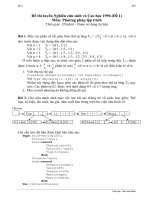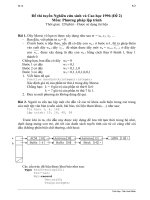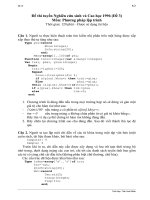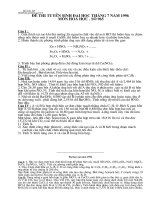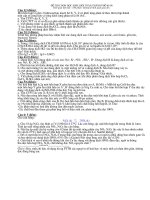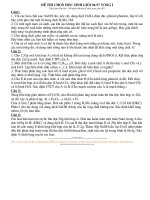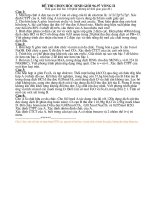- Trang chủ >>
- Đề thi >>
- Đề thi lớp 9
Havard 1996
Bạn đang xem bản rút gọn của tài liệu. Xem và tải ngay bản đầy đủ của tài liệu tại đây (163.26 KB, 7 trang )
<span class='text_page_counter'>(1)</span><div class='page_container' data-page=1>
<b>QUALIFYING EXAMINATION</b>
Harvard University
Department of Mathematics
Tuesday, March 12 (Day 1)
1. Let <i>X</i> be a compact <i>n-dimensional differentiable manifold, and</i> <i>Y</i> <i>⊂</i> <i>X</i> a closed
sub-manifold of dimension<i>m. Show that the Euler characteristicχ(X\Y</i>) of the complement
of <i>Y</i> in <i>X</i> is given by
<i>χ(X</i> <i>\Y</i>) = <i>χ(X) + (−</i>1)<i>n−m−</i>1<i>χ(Y</i>).
Does the same result hold if we do not assume that<i>X</i> is compact, but only that the Euler
characteristics of <i>X</i> and <i>Y</i> are finite?
2. Prove that the infinite sum
X
<i>p</i> prime
1
<i>p</i> =
1
2 +
1
3 +
1
5 +<i>. . .</i>
diverges.
3. Let <i>h(x) be a</i> <i>C∞</i> function on the real line R. Find a <i>C∞</i> function <i>u(x, y) on an open</i>
subset of R2 <sub>containing the</sub> <i><sub>x-axis such that</sub></i>
<i>∂u</i>
<i>∂x</i>+ 2
<i>∂u</i>
<i>∂y</i> = <i>u</i>
2
and <i>u(x,</i>0) =<i>h(x).</i>
4. a) Let<i>K</i> be a field, and let <i>L</i>=<i>K(α) be a finite Galois extension ofK</i>. Assume that
the Galois group of<i>L</i> over <i>K</i> is cyclic, generated by an automorphism sending <i>α</i> to<i>α</i>+ 1.
Prove that <i>K</i> has characteristic <i>p ></i>0 and that <i>αp</i> <i>−α∈K</i>.
b) Conversely, prove that if <i>K</i> is of characteristic<i>p, then every Galois extensionL/K</i>
of degree <i>p</i> arises in this way. (Hint: show that there exists <i>β</i> <i>∈</i> <i>L</i> with trace 1, and
construct <i>α</i> out of the various conjugates of <i>β.)</i>
</div>
<span class='text_page_counter'>(2)</span><div class='page_container' data-page=2>
0
<i>x</i> <i>dx</i>
<i>x</i>2<sub>+</sub><i><sub>x</sub></i><sub>+ 1</sub><i>.</i>
For what values of <i>α∈</i>R does the integral actually converge?
6. Let <i>M</i> <i>∈ Mn</i>(C) be a complex <i>n×n</i> matrix such that <i>M</i> is similar to its complex
conjugate <i>M</i>; i.e., there exists <i>g</i> <i>∈</i> <i>GLn</i>(C) such that <i>M</i> = <i>gM g−</i>1. Prove that <i>M</i> is
</div>
<span class='text_page_counter'>(3)</span><div class='page_container' data-page=3>
<b>QUALIFYING EXAMINATION</b>
Harvard University
Department of Mathematics
Wednesday, March 13 (Day 2)
1. Prove the Brouwer fixed point theorem: that any continuous map from the closed<i>n-disc</i>
<i>Dn</i> <i><sub>⊂</sub></i><sub>R</sub><i>n</i> <sub>to itself has a fixed point.</sub>
2. Find a harmonic function<i>f</i> on the right half-plane <i>{z</i> <i>∈</i>C<i>|</i>Re <i>z ></i>0<i>}</i>satisfying
lim
<i>x→</i>0+<i>f(x</i>+<i>iy) =</i>
½
1 if <i>y ></i>0
<i>−</i>1 if <i>y <</i>0 <i>.</i>
3. Let <i>n</i> be any integer. Show that any odd prime <i>p</i> dividing <i>n</i>2 + 1 is congruent to 1
(mod 4).
4. Let <i>V</i> be a vector space of dimension <i>n</i> over a finite field with<i>q</i> elements.
a) Find the number of one-dimensional subspaces of <i>V</i>.
b) For any <i>k</i> : 1<i>≤k≤n−</i>1, find the number of <i>k-dimensional subspaces of</i> <i>V</i>.
5. Let <i>K</i> be a field of characteristic 0. Let P<i>N</i> <sub>be the projective space of homogeneous</sub>
polynomials<i>F</i>(X, Y, Z) of degree <i>d</i>modulo scalars (N =<i>d(d</i>+ 3)/2). Let <i>W</i> <i>⊂</i>P<i>N</i> be the
subset of polynomials <i>F</i> of the form
<i>F</i>(X, Y, Z) =
<i>d</i>
Y
<i>i=1</i>
<i>Li</i>(X, Y, Z)
for some collection of linear forms <i>L</i>1<i>, . . . , Ld</i>.
a. Show that <i>W</i> is a closed subvariety of P<i>N</i><sub>.</sub>
b. What is the dimension of <i>W</i>?
c. Find the degree of <i>W</i> in case <i>d</i>= 2 and in case <i>d</i>= 3.
</div>
<span class='text_page_counter'>(4)</span><div class='page_container' data-page=4>
b. Show that if <i>M</i> <i>⊂</i> R<i>n+1</i> <sub>is a compact hypersurface, its second fundamental form</sub>
</div>
<span class='text_page_counter'>(5)</span><div class='page_container' data-page=5>
<b>QUALIFYING EXAMINATION</b>
Harvard University
Department of Mathematics
Thursday, March 14 (Day 3)
1. In R3, let <i>S,</i> <i>L</i> and <i>M</i> be the circle and lines
<i>S</i> =<i>{</i>(x, y, z) :<i>x</i>2+<i>y</i>2 = 1; <i>z</i> = 0<i>}</i>
<i>L</i> = <i>{</i>(x, y, z) :<i>x</i>=<i>y</i> = 0<i>}</i>
<i>M</i> = <i>{</i>(x, y, z) :<i>x</i>= 1
2; <i>y</i>= 0<i>}</i>
respectively.
a. Compute the homology groups of the complement R3<i><sub>\</sub></i><sub>(S</sub><i><sub>∪</sub><sub>L).</sub></i>
b. Compute the homology groups of the complement R3<i>\</i>(S<i>∪L∪M</i>).
2. Let<i>L, M, N</i> <i>⊂</i>P3
C be any three pairwise disjoint lines in complex projective threespace.
Show that there is a unique quadric surface <i>Q⊂</i>P3<sub>C</sub> containing all three.
3. Let <i>G</i> be a compact Lie group, and let <i>ρ</i> :<i>G</i> <i>→</i> <i>GL(V</i>) be a representation of <i>G</i> on a
finite-dimensional R-vector space<i>V</i>.
a) Define the <i>dual representation</i> <i>ρ∗</i> :<i>G→GL(V∗</i>) of <i>V</i>.
b) Show that the two representations <i>V</i> and <i>V∗</i> of <i>G</i> are isomorphic.
c) Consider the action of<i>SO(n) on the unit sphereSn−</i>1 <i><sub>⊂</sub></i><sub>R</sub><i>n</i><sub>, and the corresponding</sub>
representation of <i>SO(n) on the vector space</i> <i>V</i> of <i>C∞</i> R-valued functions on <i>Sn−</i>1. Show
that each nonzero irreducible <i>SO(n)-subrepresentation</i> <i>W</i> <i>⊂V</i> of <i>V</i> has a nonzero vector
fixed by <i>SO(n−</i>1), where we view <i>SO(n−</i>1) as the subgroup of<i>SO(n) fixing the vector</i>
(0, . . . ,0,1).
4. Show that if <i>K</i> is a finite extension field of Q, and <i>A</i> is the integral closure of Z in
<i>K</i>, then <i>A</i> is a free Z-module of rank [K : Q] (the degree of the field extension). (Hint:
sandwich <i>A</i> between two freeZ-modules of the same rank.)
</div>
<span class='text_page_counter'>(6)</span><div class='page_container' data-page=6>
X
0<i>kl</i>
<i>k</i>+<i>l</i>=<i>n</i>
(1)<i>l</i>
à
<i>l</i>
<i>k</i>
ả
=
1 if <i>n</i>0 (mod 3)
<i>1</i> if <i>n</i>1 (mod 3)
0 if <i>n≡</i>2 (mod 3)
<i>.</i>
(Hint: Use a generating function.)
6. Suppose <i>K</i> is integrable on R<i>n</i> and for <i>² ></i>0 define
<i>K²</i>(x) =<i>²−nK</i>(
<i>x</i>
<i>²</i>).
Suppose that R<sub>R</sub><i>nK</i> = 1.
a. Show that R<sub>R</sub><i>nK²</i> = 1 and that
R
<i>|x|>δ|K²| →</i>0 as <i>²→</i>0.
b. Suppose <i>f</i> <i>∈Lp</i>(R<i>n</i>) and for <i>² ></i>0 let <i>f²</i> <i>∈Lp</i>(R<i>n</i>) be the convolution
<i>f²</i>(x) =
Z
<i>y∈</i>R<i>n</i>
<i>f</i>(y)K<i>²</i>(x<i>−y)dy .</i>
Show that for 1<i>≤p <∞</i> we have
<i>kf²−fkp</i> <i>→</i>0 as <i>²→</i>0.
</div>
<span class='text_page_counter'>(7)</span><div class='page_container' data-page=7>
Extra problems: Let me know if you think these should replace any of the ones above,
either for balance or just by preference.
1. Suppose that <i>M</i> <i>→</i> R<i>N</i> <sub>is an embedding of an</sub> <i><sub>n-dimensional manifold into</sub></i> <i><sub>N</sub></i><sub></sub>
-dimensional Euclidean space. Endow <i>M</i> with the induced Riemannian metric. Let <i>γ</i> :
(<i>−</i>1,1) <i>→</i> <i>M</i> be a curve in M and <i>γ</i> : (<i>−</i>1,1) <i>→</i> R<i>N</i> <sub>be given by composition with the</sub>
embedding. Assume that <i>kdγ<sub>dt</sub>k ≡</i>1. Prove that <i>γ</i> is a geodesic iff
<i>d</i>2<i>γ</i>
<i>dt</i>2
is normal to <i>M</i> at <i>γ(t) for all</i> <i>t.</i>
2. Let <i>A</i> be a commutative Noetherian ring. Prove the following statements and explain
their geometric meaning (even if you do not prove all the statements below, you may use
any statement in proving a subsequent one):
a)<i>A</i>has only finitely many minimal prime ideals<i>{p</i><b>k</b><i>|k</i> = 1, . . . , n}, and every prime
ideal of <i>A</i> contains one of the<b>pk</b>.
b) T<i>n<sub>k=1</sub></i><b>pk</b> is the set of nilpotent elements of<i>A.</i>
c) If <i>A</i> is reduced (i.e., its only nilpotent element is 0), then S<i>n<sub>k=1</sub></i><b>pk</b> is the set of
zero-divisors of <i>A.</i>
4. Let <i>A</i> be the <i>n×n</i> matrix
0 1 0 <i>. . .</i> 0
0 0 1 <i>. . .</i> 0
..
. ... ... . .. ...
0 0 0 <i>. . .</i> 1
1/n 1/n 1/n <i>. . .</i> 1/n
<i>.</i>
Prove that as <i>k</i> <i>→ ∞</i>, <i>Ak</i> <sub>tends to a projection operator</sub> <i><sub>P</sub></i> <sub>onto a one-dimensional </sub>
sub-space. Find the kernel and image of <i>P</i>.
</div>
<!--links-->
